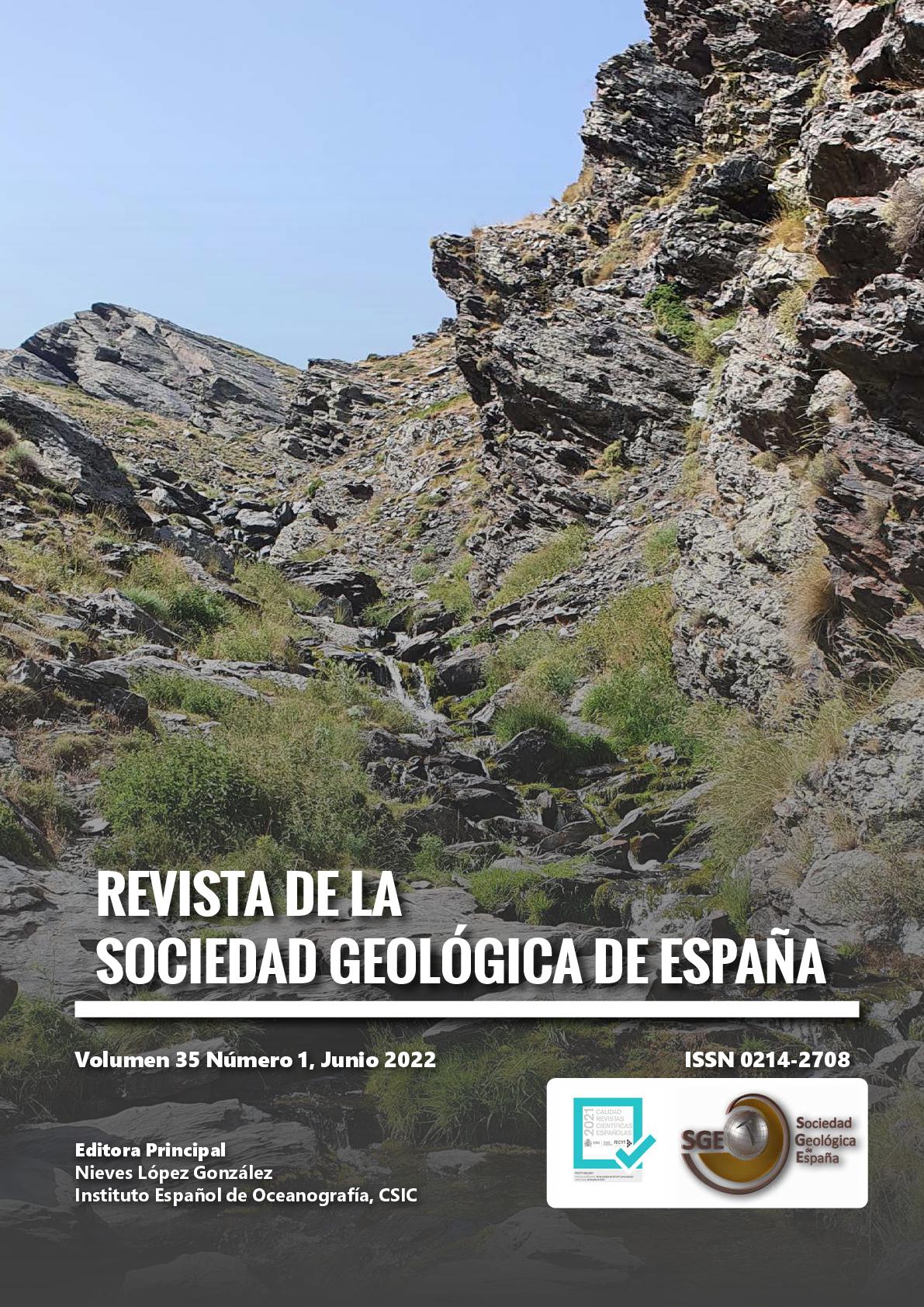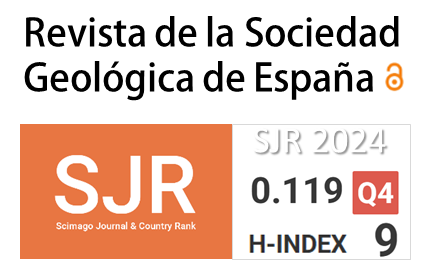Geological characterization of the Llano del Águila fault in Campo de Dalías (Almería): possible seismogenic source of the 1804 earthquake
DOI:
https://doi.org/10.55407/rsge.94908Keywords:
photogrammetry, Loma del Viento fault, Eastern Betics, Campo de Dalías, 1804 earthquakeAbstract
On August 25, 1804, an earthquake with a Mw ~6.4 and a maximum intensity of IX, caused serious damage in several locations of Campo de Dalías region (Almeria) This study provides new evidence of the relationship between this episode and the Llano del Águila fault. A NW-SE subvertical fault, with a normal-dextral slip, that runs parallel to the Loma del Viento fault, located at about 3 km to the south. For the characterization of the Llano del Águila fault, a new geomorphologic interpretation of the Quaternary alluvial deposits and their relationship with the trace of the structure has been carried out. Four generations of alluvial fans draining the Sierra de Gádor and two fault sections have been identified at a cartographic scale (Cantera Est and Rambla de la Maleza). All the geomorphologic interpretation is made by the analysis of historical aerial photos. Due the high anthropization of the area, modern elevation models are not sufficiently useful. To overcome this limitation, a digital elevation model was obtained through photogrammetry with the aerial photos of the interministerial flight (1977). Fault scarp analysis from topographic profiles measured on the new elevation model provides a 6.3 ± 1.9 m vertical slip for the Cantera East section and a 12.1 ± 1.9 m vertical slip for the Rambla de la Maleza section. All these interpretations have been verified in the field and new data on the kinematics have been acquired to estimate the net slip rate of each section. A 0.016 ± 0.002 – 0.10 ± 0.02 mm/yr slip rate has been estimated for the Cantera Est section and a 0.031 ± 0.002 – 0.19 ± 0.02 mm/yr for the Rambla de la Maleza one, for the last 126 – 781 ky (middle Pleistocene). A maximum magnitude of 6.59 ± 0.19 is estimated through empirical relationships from the total length of the fault trace.
References
Baena, J., Ewert, K., 1976. Mapa geológico de España 1:50.000, hoja nº 1058 (Roquetas de Mar). IGME, Madrid.
Balanyá, J.C., García-Dueñas, V., 1987. Les directions structurales dans le Domaine d'Alborán de part et d'autre du Détroit de Gibraltar. Comptes rendus de l'Académie des sciences. Série 2, Mécanique, Physique, Chimie, Sciences de l'univers, Sciences de la Terre, 304: 929-932.
Boncio, P., Lavecchia, G., Pace, B., 2004. Defining a model of 3D seismogenic sources for Seismic Hazard Assessment applications: The case of central Apennines (Italy). Journal of Seismology, 8: 407-425. https://doi.org/10.1023/B:JOSE.0000038449.78801.05
Buforn, E., Udías, A., Mezcua, J., 1988. Seismicity and focal mechanisms in south Spain. Bulletin of the Seismological Society of America, 78: 2008-2024.
Bull, W.B., McFadden, L.D., 1977. Tectonic geomorphology north and south of the Garlock fault, California. En: Geomorphology in arid regions, Routledge, p. 115-138. https://doi.org/10.4324/9780429299230-5
CNIG, 2015. Peligrosidad Sísmica de España. PGA. Periodo de retorno 475 años.
De Larouzière, F.D., Bolze, J., Bordet, P., Hernandez, J., Montenat, C., Ott d'Estevou, P., 1988. The Betic segment of the lithospheric Trans-Alboran shear zone during the Late Miocene. Tectonophysics, 152: 41-52. https://doi.org/10.1016/0040-1951(88)90028-5
DeMets, C., Gordon, R.G., Argus, D.F., Stein, S., 1990. Current plate motions. Geophysical journal international, 101: 425-478. https://doi.org/10.1111/j.1365-246X.1990.tb06579.x
Dewey, J.F., Helman, M.L., Knott, S.D., Turco, E., Hutton, D.H.W., 1989. Kinematics of the western Mediterranean. Geological Society, London, Special Publications, 45: 265-283. https://doi.org/10.1144/GSL.SP.1989.045.01.15
Fernández-Salas, L.M., Dabrio, C.J., Goy, J.L., Díaz, V., Zazo, C., Lobo, F.J., Sanz, J.L., Lario, J., 2009. Land - sea correlation between Late Holocene coastal and infralittoral deposits in the SE Iberian Peninsula (Western Mediterranean). Geomorphology, 104: 4-11. https://doi.org/10.1016/j.geomorph.2008.05.013
Fletcher, J. M., Teran, O. J., Rockwell, T. K., Oskin, M. E., Hudnut, K. W., Mueller, K. J., ... González-García, J., 2014. Assembly of a large earthquake from a complex fault system: Surface rupture kinematics of the 4 April 2010 El Mayor-Cucapah (Mexico) Mw 7.2 earthquake. Geosphere, 10: 797-827. https://doi.org/10.1130/GES00933.1
Galindo-Zaldívar, J., Gil, A.J., Borque, M.J., González-Lodeiro, F., Jabaloy, A., Marın-Lechado, C., Ruano, P., De Galdeano, C.S., 2003. Active faulting in the internal zones of the central Betic Cordilleras (SE, Spain). Journal of Geodynamics, 36: 239-250. https://doi.org/10.1016/S0264-3707(03)00049-8
García-Mayordomo, J., Gaspar-Escribano, J.M., Benito, B., 2007. Seismic hazard assessment of the Province of Murcia (SE Spain): analysis of source contribution to hazard. Journal of Seismology, 11: 453-471. https://doi.org/10.1007/s10950-007-9064-0
Gómez-Novell, O., García-Mayordomo, J., Ortuño, M., Masana, E., Chartier, T., 2020. Fault System-Based Probabilistic Seismic Hazard Assessment of a Moderate Seismicity Region: The Eastern Betics Shear Zone (SE Spain). Frontiers in Earth Science, 8: 579398. https://doi.org/10.3389/feart.2020.579398
Goy, J.L., Zazo, C., 1983. Los piedemontes cuaternarios de la region de almeria (españa) analisis morfologico y relacion con la neotectonica. Cuadernos do Laboratorio Xeolóxico de Laxe, 5: 397-419.
Goy, J.L., Zazo, C., Dabrio, C.J., 2003. A beach-ridge progradation complex reflecting periodical sea-level and climate variability during the Holocene (Gulf of Almería, Western Mediterranean). Geomorphology, 50: 251-268. https://doi.org/10.1016/S0169-555X(02)00217-9
Hatzfeld, D., Frogneux, M., 1981. Intermediate depth seismicity in the western Mediterranean unrelated to subduction of oceanic lithosphere. Nature, 292: 443-445. https://doi.org/10.1038/292443a0
Huerta, P., Silva, P.G., Giner-Robles, J.L., Rodríguez-Pascua, M.A., Bautista-Davila, M.B., 2015. Efectos geológicos del terremoto de Dalías-Berja 1804 ad. (Almería, SE España). En: Una visión global del Cuaternario: el hombre como condicionante de procesos geológicos, JP Galve, p. 194-197.
IGME, 2015. ZESIS; Base de Datos de Zonas Sismogénicas de la Península Ibérica y territorios de influencia para el cálculo de la peligrosidad sísmica en España. URL: http://info.igme.es/zesis/ (06/2022).
IGME 2022. QAFI: Quaternary Active Faults Database of Iberia. URL: https://info.igme.es/QAFI (06/2022).IGN-UPM, 2012. Actualización de mapas de peligrosidad sísmica de España. Centro Nacional de Información Geográfica, Instituto Geográfico Nacional, Madrid.
Instituto Andaluz de Geofísica, (IGA) Red Sísmica de Andalucía. URL: https://iagpds.ugr.es/ (06/2022).
López-Comino, J.-Á., Mancilla, F. de L., Morales, J., Stich, D., 2012. Rupture directivity of the 2011, Mw 5.2 Lorca earthquake (Spain). Geophysical Research Letters, 39: 1-5. https://doi.org/10.1029/2011GL050498
López-Marinas, J.M., 1977. Estudio del terremoto de 22 septiembre 1522 en Almería. Pub. Hidroeléctr. Esp, 16: 51-60.
Machette, M.N., 2000. Active, capable, and potentially active faults - a paleoseismic perspective. Journal of Geodynamics, 29: 387-392. https://doi.org/10.1016/S0264-3707(99)00060-5
Marín-Lechado, C., 2005. Estructura y evolución tectónica reciente del Campo de Dalías y de Níjar en el contexto del límite meridional de las Cordilleras Béticas orientales. Tesis doctoral, Univ. de Granada, 307 p.
Marín-Lechado, C., Galindo-Zaldívar, J., Rodríguez-Fernández, L.R., Pedrera, A., 2007. Mountain Front Development by Folding and Crustal Thickening in the Internal Zone of the Betic Cordillera-Alboran Sea Boundary. Pure and Applied Geophysics, 164: 1-21. https://doi.org/10.1007/s00024-006-0157-4
Marín-Lechado, C., Galindo-Zaldívar, J., Rodríguez-Fernández, L.R., Serrano, I., Pedrera, A., 2005. Active faults, seismicity and stresses in an internal boundary of a tectonic arc (Campo de Dalías and Níjar, southeastern Betic Cordilleras, Spain). Techtophysics, 396: 81-96. https://doi.org/10.1016/j.tecto.2004.11.001
Marı́n-Lechado, C., Galindo-Zaldívar, J., Rodríguez-Fernández, L.R., González-Lodeiro, F., 2004. Faulted hybrid joints: an example from the Campo de Dalias (Betic Cordilleras, Spain). Journal of Structural Geology, 26: 2025-2037. https://doi.org/10.1016/j.jsg.2004.03.006
Marı́n-Lechado, C., Galindo-Zaldı́var, J., Rodrı́guez-Fernández, L.R., 2003. Joints, faults and palaeostress evolution in the Campo de Dalias (Betic Cordilleras, southeastern Spain). Comptes Rendus Geoscience, 335: 255-264. https://doi.org/10.1016/S1631-0713(03)00035-X
Martín-Banda, R., 2020. Segmentación y evolución reciente del sistema de fallas de la Sierra de Carrascoy: implicaciones en su potencial sismogénico. Tesis Doctoral, Univ. Complutense de Madrid (Madrid, Spain), 220 p.
Martínez-Díaz, J.J., 1998. Neotectónica y tectónica activa del sector centro-occidental de la región de Murcia y sur de Almería (cordillera Bética, España). Tesis Doctoral, Univ. Complutense de Madrid, 466 p.
Martínez-Díaz, J.J., 2000. Actividad neotectónica en el sureste de Almería y su incidencia en la morfotectónica de la zona (Cordilleras Béticas). Revista de la Sociedad Geológica de España, 13: 417-429.
McCalpin, J.P., 2009. Chapter 3 Paleoseismology in Extensional Tectonic Environments. En: Paleoseismology, Academic Press, v. 95, p. 171-269. https://doi.org/10.1016/S0074-6142(09)95003-3
Milner, B.K.R., Page, M.T., Field, E.H., Parsons, T., Biasi, G.P., Bruce, E., 2013. Appendix T - Defining the Inversion Rupture Set Using Plausibility Filters, UCERF 3 Report, p. 1-14.
Murphy, P., 2019. Los terremotos de Almería de 1804, En el archivo histórico nacional. Instituto Geográfico Nacional, 600 p.
Ortuño, M., Masana, E., García-Meléndez, E., Martínez-Díaz, J., Štěpančíková, P., Cunha, P.P., Sohbati, R., Canora, C., Buylaert, J.P., Murray, A.S., 2012. An exceptionally long paleoseismic record of a slow-moving fault: The Alhama de Murcia fault (Eastern Betic shear zone, Spain). GSA Bulletin, 124: 1474-1494. https://doi.org/10.1130/B30558.1
Pedrera, A., Marín-lechado, C., Stich, D., Ruiz-Constán, A., Galindo-, J., Rey-moral, C., Lis, F. De, 2012a. Nucleation, linkage and active propagation of a segmented Quaternary normal-dextral fault: the Loma del Viento fault (Campo de Dalías, Eastern Betic Cordillera, SE Spain). Tectonophysics, 522-523: 208-217. https://doi.org/10.1016/j.tecto.2011.12.001
Pedrera, A., Galindo-Zaldívar, J., Marín-Lechado, C., García-Tortosa, F.J., Ruano, P., López-Garrido, A.C., Azañón, J.M., Peláez, J.A., Giaconia, F., 2012b. Recent and active faults and folds in the central-eastern Internal Zones of the Betic Cordillera. Journal of Iberian Geology 38 (1) 2012: 191-208. https://doi.org/10.5209/rev_JIGE.2012.v38.n1.39213
Pérez-López, R., Martín-González, F., Martínez-Díaz, J.J., Rodríguez-Pascua, M.A., 2012. Datación mediante liquenometría de los desprendimientos rocosos asociados a la sismicidad histórica en Lorca (Murcia, SE de España). Boletin Geologico y Minero, 123: 473-485.
Rodríguez-Fernández, J., Martin-Penela, A.J., 1993. Neogene evolution of the Campo de Dalias and the surrounding offshore areas - (Northeastern Alboran Sea). Geodinamica Acta, 6: 255-270. https://doi.org/10.1080/09853111.1993.11105253
Rodríguez-Fernández, J., Sanz de Galdeano, C., Serrano, F., 1990. Le couloir des Alpujarras. Documents et travaux de l'Institut géologique Albert de Lapparent, 87-100.
Roquero, E., Silva, P.G., Rodríguez-Pascua, M.A., Bardají, T., Elez, J., Carrasco-García, P. Giner-Robles, J.L., 2019. Analysis of faulted fan surfaces and paleosols in the Palomares Fault Zone (Betic Cordillera, SE Spain): Paleoclimatic and paleoseismic implications. Geomorphology, 342: 88-102. https://doi.org/10.1016/j.geomorph.2019.06.003
Sanz De Galdeano, C., 1990. Geologic evolution of the Betic Cordilleras in the Western Mediterranean, Miocene to the present. Tectonophysics, 172: 107-119. https://doi.org/10.1016/0040-1951(90)90062-D
Silva, P.G., Rodríguez-Pascua, M.A., Giner-Robles, J.L., Pérez-López, R., Lario J., Perucha-Atienza, M.A., Bardají-Azcárate, T., Huerta-Hurtado, P., Roquero, E., Bautista-Davila, M.B. 2019. Catálogo de Efectos Geológicos de los terremotos en España, 2a Edición (Revisada y ampliada). Madrid, IGME, 804 p.
Silva, P.G., Goy, J.L., Zazo, C., Bardaj, T., Dabrio, C.J., Lario, J., 1992. Evaluación geomorfológica de la actividad neotectónica cuaternaria a lo largo de frentes montañosos de falla en el SE de España. Actas III Congreso Geológico de España, VIII Congreso Latinoamericano de Geologia, 2: 96-100.
Snavely, N., Seitz, S.M., Szeliski, R., 2008. Modeling the World from Internet Photo Collections. International Journal of Computer Vision, 80: 189-210. https://doi.org/10.1007/s11263-007-0107-3
Solares, J.M.M., Rodríguez, J.M., 2002. Catálogo sísmico de la Península Ibérica: (880 a. C-1900): Ministerio de Fomento.
Srivastava, S.P., Roest, W.R., Kovacs, L.C., Oakey, G., Lévesque, S., Verhoef, J., Macnab, R., 1990. Motion of Iberia since the Late Jurassic: Results from detailed aeromagnetic measurements in the Newfoundland Basin. Tectonophysics, 184: 229-260. https://doi.org/10.1016/0040-1951(90)90442-B
Stich, D., Alguacil, G., Morales, J., 2001. The relative locations of multiplets in the vicinity of the Western Almería (southern Spain) earthquake series of 1993-1994. Geophysical Journal International, 146: 801-812. https://doi.org/10.1046/j.0956-540x.2001.01498.x
Stich, D., Batlló, J., Morales, J., Macià, R., Dineva, S., 2003. Source parameters of the MW= 6.1 1910 Adra earthquake (southern Spain). Geophysical Journal International, 155: 539-546. https://doi.org/10.1046/j.1365-246X.2003.02059.x
Wallace, R.E., 1980. Discussion-Nomograms for estimating components of fault displacement from measured height of fault scarp. Bulletin of the Association of Engineering Geologists, 17: 39-45. https://doi.org/10.2113/gseegeosci.xvii.1.39
Wells, D.L., Coppersmith, K.J., 1994. New Empirical Relationships among Magnitude, Rupture Length, Rupture Width, Rupture Area, and Surface Displacement. Bulletin - Seismological Society of America, 84: 974-1002.
Westoby, M.J., Brasington, J., Glasser, N.F., Hambrey, M.J. Reynolds, J.M., 2012. 'Structure-from-Motion' photogrammetry: A low-cost, effective tool for geoscience applications. Geomorphology, 179: 300-314. https://doi.org/10.1016/j.geomorph.2012.08.021
Downloads
Published
Versions
- 2023-06-19 (3)
- 2022-10-11 (2)
How to Cite
Issue
Section
License

The Author retains the copyright and grants to the Geological Society of Spain the right of first publication and grants non-exclusive distribution rights for this article for the duration of the literary property under Spanish law, in all current or future media, being the work available simultaneously to its publication under the Creative Commons CC BY-NC-SA 4.0 license, which allows copying and transforming the work, but taking into account that the distribution of the transformed work must be under the same license and never for commercial purposes, while acknowledging authorship and original publication in the Revista de la Sociedad Geológica de España.










